
|
Now it is 8.0 mag (Apr. 22, Salvador Aguirre). Fading slowly. In the Northern Hemisphere, it will be unobservable at 10 mag in June. In the Southern Hemisphere, it is observable in the evening low sky from April to June.
Date(TT) R.A. (2000) Decl. Delta r Elong. m1 Best Time(A, h)
Apr. 21 8 54.40 43 29.4 1.943 2.221 92 8.3 20:07 (126, 74)
Apr. 28 8 50.79 39 33.1 2.115 2.284 86 8.6 20:15 (109, 67)
|

|
Big asteroid discovered in 1906. It suddenly showed the cometary activity on Dec. 11, 2010, probably due to an impact of a small object. It was very bright as 11.5 mag visually (Dec. 17, 2010, Juan Jose Gonzalez). It has already turned to be stellar.
Date(TT) R.A. (2000) Decl. Delta r Elong. m1 Best Time(A, h)
Apr. 21 17 0.98 -18 12.3 1.632 2.448 134 12.8 3:04 ( 0, 37)
Apr. 28 16 59.04 -18 44.6 1.572 2.447 142 12.6 2:35 ( 0, 36)
|
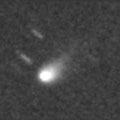
|
Already so bright as 11.6 mag and visible visually (Apr. 21, Carlos Labordena). It is expected to be bright as 9 mag from 2012 to 2013. In the Northern Hemisphere, it keeps observable in good condition for a long time until 2012 autumn when the comet brightens up to 10 mag. In the Southern Hemisphere, it is hardly observble before the perihelion passage. But it becomes observable in good condition since 2013 after the perihelion passage.
Date(TT) R.A. (2000) Decl. Delta r Elong. m1 Best Time(A, h)
Apr. 21 15 16.83 56 41.6 3.114 3.576 109 13.0 1:20 (180, 68)
Apr. 28 15 7.65 56 48.5 3.062 3.513 108 12.9 0:44 (180, 68)
|

|
It brightened up to 9 mag in January and February in the evening low sky. In the Southern Hemisphere, it is observable in the evening extremely low sky in April and May. It will never be observable again in the Northern Hemisphere.
Date(TT) R.A. (2000) Decl. Delta r Elong. m1 Best Time(A, h)
Apr. 21 3 43.26 2 9.2 2.199 1.398 28 13.1 20:07 ( 95, -3)
Apr. 28 4 6.61 2 28.7 2.265 1.458 28 13.5 20:15 ( 97, -6)
|

|
Now it is 12.2 mag (Mar. 25, Jakub Koukal). It is already low in the evening. It will be unobservable at the end of April.
Date(TT) R.A. (2000) Decl. Delta r Elong. m1 Best Time(A, h)
Apr. 21 4 22.59 17 48.8 2.897 2.164 35 13.5 20:07 (103, 13)
Apr. 28 4 38.48 18 19.0 2.961 2.186 32 13.6 20:15 (106, 10)
|

|
Now it is bright as 13.4 mag (Mar. 27, Jakub Cerny). It keeps 13-14 mag and observable in good condition until September.
Date(TT) R.A. (2000) Decl. Delta r Elong. m1 Best Time(A, h)
Apr. 21 17 44.59 -13 20.4 4.497 5.131 124 13.6 3:48 ( 0, 42)
Apr. 28 17 36.78 -13 13.4 4.394 5.132 132 13.5 3:13 ( 0, 42)
|

|
Now it is bright as 12.8 mag and visible visually (Mar. 14, John Drummond). It keeps bright as 13-14 mag for a long time after this until 2013. It is not observable in the Northern Hemisphere, but it is observable in good condition in the Southern Hemisphere.
Date(TT) R.A. (2000) Decl. Delta r Elong. m1 Best Time(A, h)
Apr. 21 3 24.13 -59 34.3 5.714 5.516 73 13.6 20:07 ( 37,-35)
Apr. 28 3 32.51 -58 23.9 5.716 5.524 73 13.6 20:15 ( 40,-38)
|

|
It brightened much faster than expected. It is so bright as 11.8 mag and visible visually (Apr. 22, Uwe Pilz). In the Northern Hemisphere, it keeps observable at 12-14 mag in good condition until early 2013. In the Southern Hemisphere, it is not observable until late 2012.
Date(TT) R.A. (2000) Decl. Delta r Elong. m1 Best Time(A, h)
Apr. 21 21 12.79 63 47.4 2.524 2.393 70 13.7 3:50 (211, 48)
Apr. 28 21 29.37 68 40.2 2.490 2.358 70 13.6 3:40 (204, 46)
|
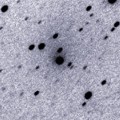
|
Now it is visible visually at 13.6 mag (Mar. 22, Carlos Labordena).
Date(TT) R.A. (2000) Decl. Delta r Elong. m1 Best Time(A, h)
Apr. 21 12 12.61 -11 39.5 5.335 6.258 154 13.6 22:13 ( 0, 43)
Apr. 28 12 10.26 -11 21.4 5.383 6.258 147 13.6 21:43 ( 0, 44)
|

|
Now it is very bright at 12.5 mag (Apr. 1, Michael Jager). In the Northern Hemisphere, it locates extremely low in the morning until June. It will be observable at high location after summer. In the Southern Hemisphere, it will never be observable again.
Date(TT) R.A. (2000) Decl. Delta r Elong. m1 Best Time(A, h)
Apr. 21 1 11.13 33 28.9 2.762 1.888 23 13.7 3:50 (231, 4)
Apr. 28 1 31.08 35 19.8 2.830 1.955 24 13.9 3:40 (230, 5)
|

|
Now it is 14.3 mag (Mar 13, Jakub Cerny). It is already unobservable in the Northern Hemisphere. In the Southern Hemisphere, it locates extremely low now. But it will be getting higher gradually after May. It is expected to be observable at 11-13 mag for a long time from 2012 summer to 2013 summer. It will be observable in excellent condition in the Southern Hemisphere. But it is not observable until 2013 January in the Northern Hemisphere.
Date(TT) R.A. (2000) Decl. Delta r Elong. m1 Best Time(A, h)
Apr. 21 1 53.92 -33 8.7 3.573 2.950 45 14.0 3:50 (285,-42)
Apr. 28 2 1.52 -33 48.3 3.468 2.896 48 13.8 3:40 (287,-41)
|
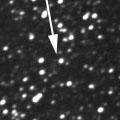
|
It is expected to be a great comet of -1 mag in 2013 spring. It is already bright and visible visually at 14.3 mag (Mar. 30, Alan Hale). Brightening faster than originally expected. In 2012, it keeps observable until summer while brightening gradually. It locates somewhat low in the Northern Hemisphere.
Date(TT) R.A. (2000) Decl. Delta r Elong. m1 Best Time(A, h)
Apr. 21 16 48.78 -25 16.6 4.114 4.898 137 14.0 2:52 ( 0, 30)
Apr. 28 16 43.58 -25 28.1 3.964 4.823 145 13.8 2:20 ( 0, 30)
|
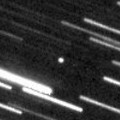
|
It will pass the perihelion on May 2. But it is not observable when it becomes bright at this apparition.
Date(TT) R.A. (2000) Decl. Delta r Elong. m1 Best Time(A, h)
Apr. 21 3 22.10 14 48.0 1.163 0.427 21 14.9 20:07 (108, 0)
Apr. 28 3 15.33 13 22.6 0.963 0.225 12 14.4 20:15 (114,-10)
|

|
Now it is visible visually at 13.9 mag (Mar. 26, Jakub Cerny). It is expected to be 13 mag and will be observable in good condition in 2013. In the Northern Hemisphere, it will be getting higher gradually in the morning sky, and keeps observable for a long time. It is not observable in the Southern Hemisphere.
Date(TT) R.A. (2000) Decl. Delta r Elong. m1 Best Time(A, h)
Apr. 21 23 26.74 49 56.4 7.135 6.518 48 14.5 3:50 (227, 29)
Apr. 28 23 27.99 50 25.1 7.091 6.497 50 14.4 3:40 (228, 32)
|

|
Although it has been unobservable for a while, now it is appearing in the morning sky. Now it is 14.3 mag (Mar. 27, Jakub Cerny). After this, it will be observable in good condition in the Southern Hemisphere while fading gradually. It will locate somewhat low in the Northern Hemisphere. In 2011, some visual observers reported it was very bright as 10-12 mag.
Date(TT) R.A. (2000) Decl. Delta r Elong. m1 Best Time(A, h)
Apr. 21 22 6.95 -13 54.0 3.051 2.733 62 14.5 3:50 (296, 11)
Apr. 28 22 17.02 -13 53.2 3.009 2.773 66 14.5 3:40 (297, 13)
|

|
It brightened up to 17.1 mag in late June in 2011 (June 24, J. F. Hernandez). The condition of this apparition is bad, and it was not observable around the perihelion passage. It is appearing in the morning sky in the Southern Hemisphere, but it locates extremely low. It will not be observable until June in the Northern Hemisphere, when the comet will be 15.5 mag.
Date(TT) R.A. (2000) Decl. Delta r Elong. m1 Best Time(A, h)
Apr. 21 23 47.63 -8 56.0 2.652 1.961 38 14.5 3:50 (277, -5)
Apr. 28 0 1.48 -7 33.6 2.643 1.998 41 14.6 3:40 (277, -4)
|

|
Now it is so bright as 12.3 mag and visible visually (Mar. 22, Carlos Labordena). Although it was extremely faint as 20.5 mag at the recovery in 2010 autumn, it brightened rapidly. It will keep 12-14 mag and observable in good condition for a long time from 2012 to 2013. But it locates somewhat low in the Northern Hemisphere in 2013.
Date(TT) R.A. (2000) Decl. Delta r Elong. m1 Best Time(A, h)
Apr. 21 13 6.93 14 40.1 2.320 3.234 150 14.7 23:06 ( 0, 70)
Apr. 28 13 2.33 14 35.2 2.341 3.219 145 14.7 22:34 ( 0, 70)
|

|
This comet brightened up to 10 mag in outburst in 1995, however, it became lost after that. The condition of this apparition is bad. It is not observable around the perihelion passage. Maybe it can be recovered after summer when it appears in the morning sky.
Date(TT) R.A. (2000) Decl. Delta r Elong. m1 Best Time(A, h)
Apr. 21 1 13.66 3 39.0 2.339 1.381 13 15.4 3:50 (254,-15)
Apr. 28 1 36.77 5 14.5 2.344 1.391 14 15.1 3:40 (252,-15)
|

|
It reached up to 9.7 mag with a large bright coma in last autumn (Oct. 29, Juan Jose Gonzalez). Now it is fading. It has already faded down to 14.6 mag (Mar. 21, Jakub Cerny). It is already unobservable in the Northern Hemisphere. It will be unobservable in late April in the Southern Hemisphere.
Date(TT) R.A. (2000) Decl. Delta r Elong. m1 Best Time(A, h)
Apr. 21 3 39.03 -9 3.7 4.102 3.306 33 15.4 20:07 ( 86,-11)
Apr. 28 3 44.98 -9 30.3 4.183 3.364 31 15.5 20:15 ( 90,-17)
|

|
Now it is 16.0 mag (Mar. 26, Jakub Cerny). In the Southern Hemisphere, it will be observable at 15-16 mag in good condition for a long time until 2013 summer. It is not observable at all in the Northern Hemisphere.
Date(TT) R.A. (2000) Decl. Delta r Elong. m1 Best Time(A, h)
Apr. 21 20 21.69 -52 41.1 3.803 4.027 95 15.4 3:50 (338, -4)
Apr. 28 20 27.63 -54 40.4 3.700 4.011 100 15.4 3:40 (340, -5)
|
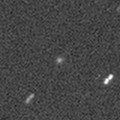
|
Now it is 17.3 mag (Apr. 14, Yasukazu Ikari). It will brighten up to 13.5 mag from summer to autumn. It keeps observable for a long time until December. In the Northern Hemisphere, it locates high until spring. But after that, it keeps locating low in the evening. In the Southern Henmisphere, it keeps locating low all through the time.
Date(TT) R.A. (2000) Decl. Delta r Elong. m1 Best Time(A, h)
Apr. 21 10 51.07 36 31.3 1.986 2.576 114 16.6 20:51 (180, 89)
Apr. 28 10 48.74 36 32.5 1.991 2.501 108 16.5 20:21 (180, 89)
|
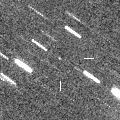
|
Now it is 17.6 mag (Mar. 13, Toshiyuki Takahashi). It brightened rapidly as expected. It will reach up to 16.5 mag from spring to summer. However, it locates extremely low in the Southern Hemisphere. In the Northern Hemisphere, it is getting lower gradually in the evening sky, and will be unobservable in June.
Date(TT) R.A. (2000) Decl. Delta r Elong. m1 Best Time(A, h)
Apr. 21 5 26.07 22 5.4 2.067 1.633 51 16.7 20:07 ( 98, 29)
Apr. 28 5 46.78 22 7.6 2.097 1.625 49 16.6 20:15 (100, 26)
|

|
Now it is 16.9 mag (Apr. 14, Yasukazu Ikari). It is expected to keep 13 mag and observable in good condition in the Northern Hemisphere for a long time from 2013 to 2014. It keeps observable at 17-18 mag in good condition until June.
Date(TT) R.A. (2000) Decl. Delta r Elong. m1 Best Time(A, h)
Apr. 21 10 32.57 9 37.9 5.685 6.317 125 16.8 20:33 ( 0, 65)
Apr. 28 10 29.52 10 22.3 5.745 6.271 117 16.8 20:15 ( 8, 65)
|
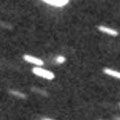
|
Now it is 16.7 mag (Apr. 14, Yasukazu Ikari). It keeps observable at 17 mag for a long time from 2011 to 2013. In 2012, it keeps observable in good condition until early September.
Date(TT) R.A. (2000) Decl. Delta r Elong. m1 Best Time(A, h)
Apr. 21 15 53.89 5 48.0 4.766 5.625 145 16.9 1:58 ( 0, 61)
Apr. 28 15 45.33 6 25.5 4.722 5.623 150 16.9 1:22 ( 0, 61)
|
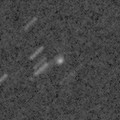
|
Now it is 16.7 mag (Apr. 21, Catalina Sky Survey). In the Northern Hemisphere, it keeps observable at 16-17 mag in good condition for a long time from 2012 to 2013. It is not observable in the Southern Hemisphere.
Date(TT) R.A. (2000) Decl. Delta r Elong. m1 Best Time(A, h)
Apr. 21 9 43.50 65 57.5 3.843 3.965 89 16.9 20:07 (175, 59)
Apr. 28 9 29.45 65 36.7 3.916 3.937 83 16.9 20:15 (166, 58)
|

|
Now it is 18.2 mag (Apr. 20, Pierre Auger Observatory). It will brighten rapidly after this. It will approach to the sun down to 0.12 A.U. on July 14. In the Southern Hemisphere, it keeps observable in good condition except for mid July only, in the morning sky before the perihelion passage, and in the evening sky after the perihelion passage. In the Northern Hemisphere, it is not observable before the perihelion passage. But it will appear in the evening sky at 8 mag in late July. Then it keeps observable while fading rapidly in the evening low sky.
Date(TT) R.A. (2000) Decl. Delta r Elong. m1 Best Time(A, h)
Apr. 21 23 6.07 -37 44.1 2.066 1.852 63 17.5 3:50 (307,-14)
Apr. 28 23 27.30 -37 25.3 1.900 1.751 65 17.0 3:40 (306,-14)
|

|
It has not been observed since 2011 March. But it must be already bright as 17.5 mag. It will brighten up to 17 mag and will be observable in good condition from spring to summer.
Date(TT) R.A. (2000) Decl. Delta r Elong. m1 Best Time(A, h)
Apr. 21 19 14.81 -11 19.2 1.636 2.093 102 17.3 3:50 (332, 39)
Apr. 28 19 21.95 -10 23.8 1.577 2.105 107 17.2 3:40 (334, 41)
|

|
Now it is 17.5 mag (Apr. 19, C. Bell). It tends to brighten after the perihelion passage. It keeps observable at 17 mag from 2012 to 2013. It locates somewhat low in the Northern Hemisphere.
Date(TT) R.A. (2000) Decl. Delta r Elong. m1 Best Time(A, h)
Apr. 21 16 46.36 -15 10.2 2.322 3.146 138 17.3 2:50 ( 0, 40)
Apr. 28 16 44.44 -15 12.5 2.258 3.141 145 17.3 2:20 ( 0, 40)
|
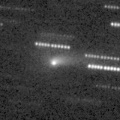
|
It reached up to 11-12 mag in 2011 autumn. Now it is fading. It has already faded down to 17.0 mag (Apr. 15, A. Diepvens). It keeps observable in good condition until May when it becomes fainter than 18 mag. It locates somewhat low in the Southern Hemisphere.
Date(TT) R.A. (2000) Decl. Delta r Elong. m1 Best Time(A, h)
Apr. 21 11 46.59 29 58.0 1.594 2.349 127 17.4 21:47 ( 0, 85)
Apr. 28 11 46.07 29 7.0 1.699 2.397 122 17.6 21:19 ( 0, 84)
|

|
It brightened up to 13-14 mag and became visible visually from 2007 to 2009. Now it is fading. But it is still bright as 16.9 mag (Mar. 19, V. Gerke, S. Plaksa, A. Novichonok). In the Northern Hemisphere, it keeps observable in excellent condition until early summer in 2012. In the Southern Hemisphere, it locates extremely low only.
Date(TT) R.A. (2000) Decl. Delta r Elong. m1 Best Time(A, h)
Apr. 21 9 53.24 39 58.7 11.461 11.738 103 17.4 20:07 (152, 84)
Apr. 28 9 51.35 39 44.9 11.604 11.774 97 17.5 20:15 (119, 79)
|

|
Now it is 16.4 mag (Apr. 15, J. F. Hernandez). It will brighten up to 13 mag in 2014. In 2012, it is observable at 17 mag in good condition in spring.
Date(TT) R.A. (2000) Decl. Delta r Elong. m1 Best Time(A, h)
Apr. 21 10 54.93 17 27.1 3.569 4.245 126 17.5 20:55 ( 0, 72)
Apr. 28 10 53.49 17 17.9 3.641 4.230 119 17.6 20:26 ( 0, 72)
|

|
Brightening faster than expected. Now it is 17.5 mag (Apr. 12, Michael Jager). It will be getting lower in the evening after this. It keeps observable at 17 mag until mid June in the Northern Hemisphere, or until mid July in the Southern Hemisphere.
Date(TT) R.A. (2000) Decl. Delta r Elong. m1 Best Time(A, h)
Apr. 21 8 8.18 21 2.5 2.534 2.702 88 17.9 20:07 ( 69, 61)
Apr. 28 8 15.19 20 44.4 2.580 2.660 83 17.8 20:15 ( 76, 55)
|
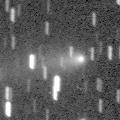
|
It had been fading after the perihelion passage in 2010 October, but it brightened again in outburst on Apr. 5, 2011. It reached up to 14.7 mag in May (May 28, Hidetaka Sato). It is bright as 17.5 mag still now, much brighter than expected (Apr. 16, Catalina Sky Survey). It locates low in the Southern Hemisphere. But in the Northern Hemisphere, it keeps observable in good condition after this. It will keep 18 mag for a while.
Date(TT) R.A. (2000) Decl. Delta r Elong. m1 Best Time(A, h)
Apr. 21 13 10.95 21 42.6 3.268 4.129 144 18.0 23:10 ( 0, 77)
Apr. 28 13 6.25 21 34.6 3.335 4.154 139 18.1 22:38 ( 0, 76)
|
|
![]()
 C/2010 G2 ( Hill )
C/2010 G2 ( Hill ) C/2011 O1 ( LINEAR )
C/2011 O1 ( LINEAR ) C/2012 CH17 ( MOSS )
C/2012 CH17 ( MOSS ) 60P/Tsuchinshan 2
60P/Tsuchinshan 2 C/2011 J2 ( LINEAR )
C/2011 J2 ( LINEAR ) C/2010 R1 ( LINEAR )
C/2010 R1 ( LINEAR ) C/2012 A2 ( LINEAR )
C/2012 A2 ( LINEAR ) 96P/Machholz 1
96P/Machholz 1 105P/Singer Brewster
105P/Singer Brewster 152P/Helin-Lawrence
152P/Helin-Lawrence 49P/Arend-Rigaux
49P/Arend-Rigaux C/2005 L3 ( McNaught )
C/2005 L3 ( McNaught ) 117P/Helin-Roman-Alu 1
117P/Helin-Roman-Alu 1 C/2012 BJ98
C/2012 BJ98 240P/2010 P1 ( NEAT )
240P/2010 P1 ( NEAT )![]()




























